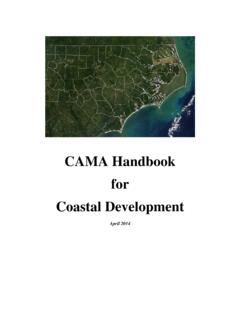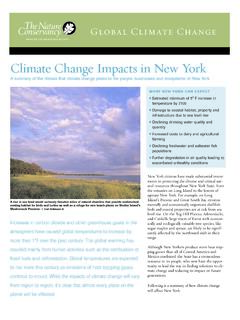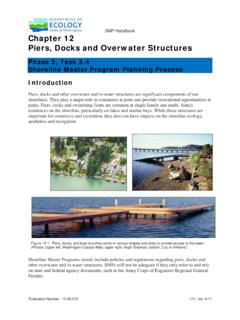Transcription of Climate Change Impacts on Marine Ecosystems
1 MA04CH02-Doney ARI 3 November 2011 13:27. ANNUAL. REVIEWS Further Climate Change Impacts Click here for quick links to Annual Reviews content online, including: on Marine Ecosystems Other articles in this volume Top cited articles Scott C. Doney,1 Mary Ruckelshaus, J. Emmett Duffy, Top downloaded articles by Massachusetts Institute of Technology (MIT) on 09/21/12. For personal use only. James P. Barry, Francis Chan, Chad A. English, Annu. Rev. Marine . Sci. :11-37. Downloaded from Our comprehensive search Heather M. Galindo, Jacqueline M. Grebmeier, Anne B. Hollowed, Nancy Knowlton, Jeffrey Polovina, Nancy N. Rabalais, William J. Sydeman, and Lynne D. Talley 1. Marine Chemistry and Geochemistry Department, Woods Hole Oceanographic Institution, Woods Hole, Massachusetts 02543; email: . Annu. Rev. Mar. Sci. 2012. 4:11 37 Keywords First published online as a Review in Advance on trophic structure, hypoxia, diversity, food webs August 25, 2011.
2 The Annual Review of Marine Science is online at Abstract In Marine Ecosystems , rising atmospheric CO2 and Climate Change are asso- This article's doi: ciated with concurrent shifts in temperature, circulation, strati cation, nu- trient input, oxygen content, and ocean acidi cation, with potentially wide- Copyright c 2012 by Annual Reviews. ranging biological effects. Population-level shifts are occurring because of All rights reserved physiological intolerance to new environments, altered dispersal patterns, 1941-1405/12/0115-0011$ and changes in species interactions. Together with local Climate -driven in- . Af liations for all coauthors can be found in the vasion and extinction, these processes result in altered community structure Acknowledgments section. and diversity, including possible emergence of novel Ecosystems . Impacts are particularly striking for the poles and the tropics, because of the sensitivity of polar Ecosystems to sea-ice retreat and poleward species migrations as well as the sensitivity of coral-algal symbiosis to minor increases in temper- ature.
3 Midlatitude upwelling systems, like the California Current, exhibit strong linkages between Climate and species distributions, phenology, and demography. Aggregated effects may modify energy and material ows as well as biogeochemical cycles, eventually impacting the overall ecosystem functioning and services upon which people and societies depend. 11. MA04CH02-Doney ARI 3 November 2011 13:27. INTRODUCTION. Marine Ecosystems are maintained by the ow of energy from primary producers at the base of food webs through to intermediate consumers, top predators (including humans), and pathogens, and then back again through decomposition and detrital pathways. Thus, Marine communities are biological networks in which the success of species is linked directly or indirectly through various biological interactions ( , predator-prey relationships, competition, facilitation, mutualism) to the performance of other species in the community.
4 The aggregate effect of these interactions constitutes ecosystem function ( , nutrient cycling, primary and secondary productivity), through which ocean and coastal Ecosystems provide the wealth of free natural bene ts that society depends upon, such as sheries and aquaculture production, water puri cation, shoreline protection, and recreation. However, growing human pressures, including Climate Change , are having profound and diverse consequences for Marine Ecosystems . Rising atmospheric carbon dioxide (CO2 ) is one of by Massachusetts Institute of Technology (MIT) on 09/21/12. For personal use only. Annu. Rev. Marine . Sci. :11-37. Downloaded from the most critical problems because its effects are globally pervasive and irreversible on ecological timescales (Natl. Res. Counc. 2011). The primary direct consequences are increasing ocean temperatures (Bindoff et al.)
5 2007) and acidity (Doney et al. 2009). Climbing temperatures create a host of additional changes, such as rising sea level, increased ocean strati cation, decreased sea-ice extent, and altered patterns of ocean circulation, precipitation, and freshwater input (Figure 1a). In addition, both warming and altered ocean circulation act to reduce subsurface oxygen (O2 ) concentrations (Keeling et al. 2010). In recent decades, the rates of Change have been rapid and may exceed the current and potential future tolerances of many organisms to adapt. Further, the rates of physical and chemical Change in Marine Ecosystems will almost certainly accelerate over the next several decades in the absence of immediate and dramatic efforts toward Climate mitigation (Natl. Res. Counc. 2011). Direct effects of changes in ocean temperature and chemistry may alter the physiological func- tioning, behavior, and demographic traits ( , productivity) of organisms, leading to shifts in the size structure, spatial range, and seasonal abundance of populations.
6 These shifts, in turn, lead to altered species interactions and trophic pathways as Change cascades from primary producers to upper-trophic-level sh, seabirds, and Marine mammals, with Climate signals thereby propa- gating through Ecosystems in both bottom-up and top-down directions. Changes in community structure and ecosystem function may result from disruptions in biological interactions. There- fore, investigating the responses of individual species to single forcing factors, although essential, provides an incomplete story and highlights the need for more comprehensive, multispecies- to ecosystem-level analyses. The effects of rising CO2 do not act in isolation. Additional regional pressures on ocean Ecosystems (Figure 1b) include intensive use of fertilizers, coastal and benthic habitat degradation, overexploitation of sh stocks, rising aquaculture production, and invasive species (Halpern et al.)
7 2008). coastal hypoxia is increasing and expanding globally (Diaz & Rosenberg 2008). Ecosystem deterioration is intense and increasing, particularly for coastal systems, with 50% of salt marshes, 35% of mangroves, 30% of coral reefs, and 29% of seagrasses already either lost or degraded worldwide ( Jackson 2010). Thus, the integrated and synergistic effects of these multiple stressors on Marine Ecosystems both CO2 and non-CO2 related must be considered in total, not as independent issues (Doney 2010). There have been few systematic reviews of the Impacts of rising CO2 and Climate Change on Marine Ecosystems ( , Hoegh-Guldberg & Bruno 2010). Here, we document the emerging science in this eld, cutting across biological scales from organisms to Ecosystems and illustrating general points with three case studies sea-ice-dependent polar Ecosystems , shallow tropical and 12 Doney et al.
8 MA04CH02-Doney ARI 3 November 2011 13:27. 1 2 3 4 5 6. 13 900. a 150 10. Summer Arctic sea-ice area (106 km2). 0 700-m ocean heat content (1022 J). Mean ocean-surface pH (total scale). 12 800. Sea-surface temperature ( C). Global mean sea level (mm). 100. 11 5 700. 50. pCO2 ( atm). 10 600. 0 0 9 500. 50. 8 5 400. 100 7 300. by Massachusetts Institute of Technology (MIT) on 09/21/12. For personal use only. 10. Annu. Rev. Marine . Sci. :11-37. Downloaded from 150. 6 200. 1000 1800 1900 2000 2100. Year World population coastal population 10. Anthropogenic nitrogen fixation b North American Marine biological invasions 9. Global Marine wild fish harvest Cumulative seagrass loss 8. Cumulative Caribbean coral cover loss 7. Cumulative mangrove loss Relative Change Relative Change Cumulative global hypoxic zones 6. Global mariculture production 5. 4. 3. 2. 1. 0. 1800 1850 1900 1950 2000.
9 Year Figure 1. (a) Changes in global mean sea level (teal line; Jevrejeva et al. 2008), summer Arctic sea-ice area ( yellow line; Walsh & Chapman 2001), 0 700-m ocean heat content (orange line; Levitus et al. 2009), sea-surface temperature (brown line; Rayner et al. 2006), mean ocean-surface pH (blue line; Natl. Res. Counc. 2010), and atmosphere pCO2 (red line; Petit et al. 1999). Light purple shaded region denotes projected changes in pH and pCO2 consistent with the Intergovernmental Panel on Climate Change 's twenty- rst-century A2 emissions scenario with rapid population growth. (b) Time series (as identi ed in gure key): trends in world population (Goldewijk 2005), coastal population (Wilson & Fischetti 2010), anthropogenic nitrogen xation (Davidson 2009), North American Marine biological invasions (Ruiz et al. 2000), global Marine wild sh harvest (Food Agric.)
10 Org. 2010), cumulative seagrass loss (Waycott et al. 2009), cumulative Caribbean coral cover loss (Gardner et al. 2003), cumulative mangrove loss (Food Agric. Org. 2007), cumulative global hypoxic zones (Diaz & Rosenberg 2008), and global mariculture production (Food Agric. Org. 2010). All time series in panel b are normalized to 1980 levels. Trends with < variation are depicted as solid lines (left axis), and trends with > variation are depicted as dotted lines (right axis). Climate Change Impacts on Marine Ecosystems 13. MA04CH02-Doney ARI 3 November 2011 13:27. subtropical regions (coral reef systems), and an upwelling system (the California Current) where substantial Change is evident already and susceptibility to further Change is likely. IPCC: Intergovernmental Climate AND GLOBAL Change . Panel on Climate Change Humans in uence Climate primarily through fossil-fuel, industrial, agricultural, and other land- SST: sea-surface use emissions that alter atmospheric composition.







